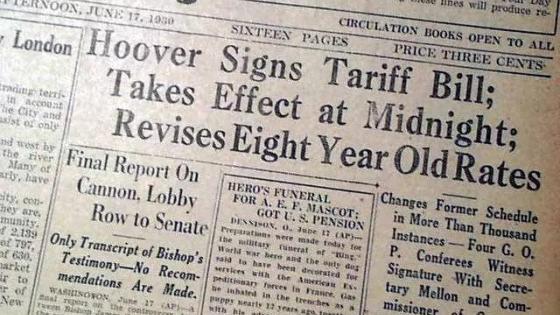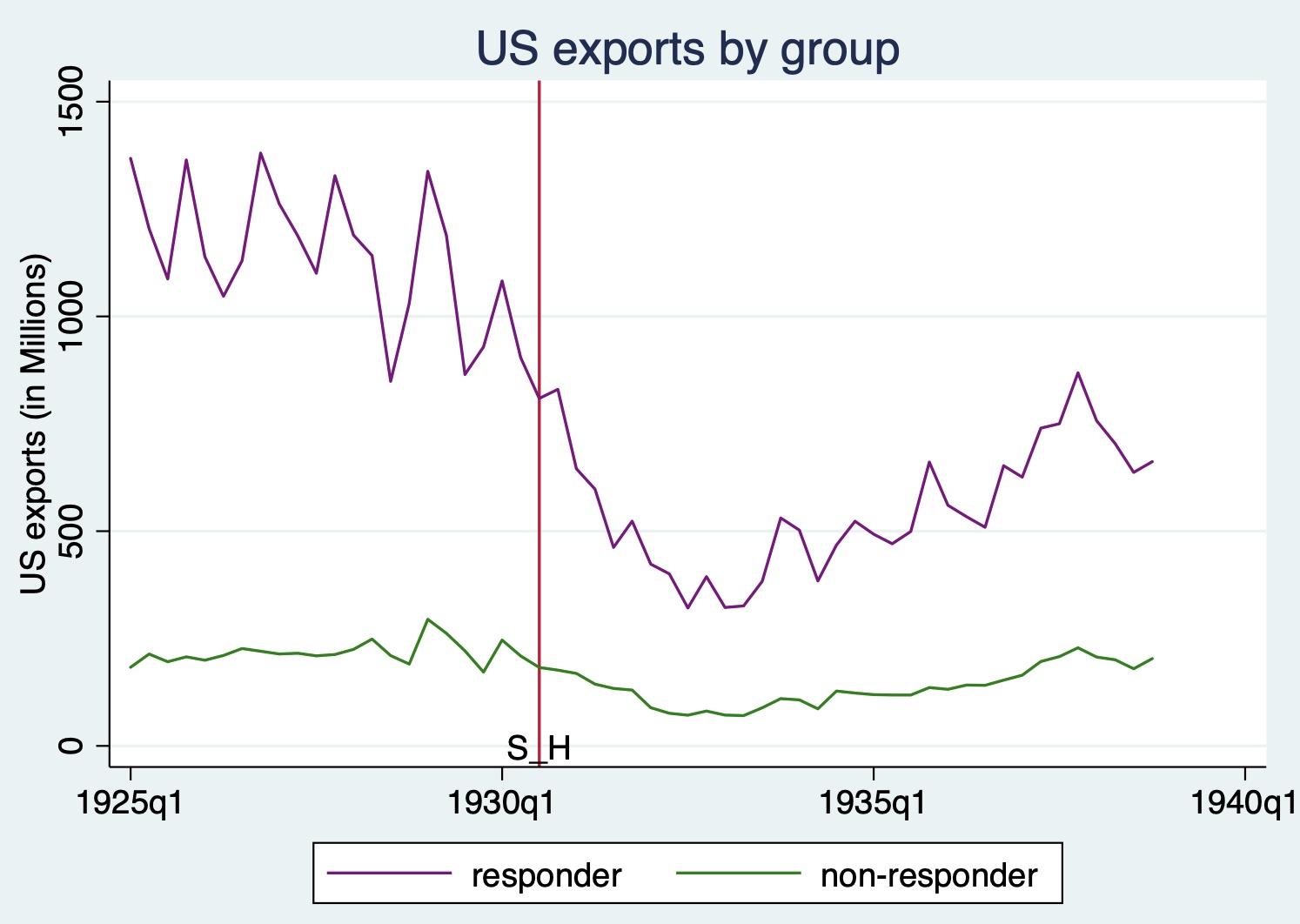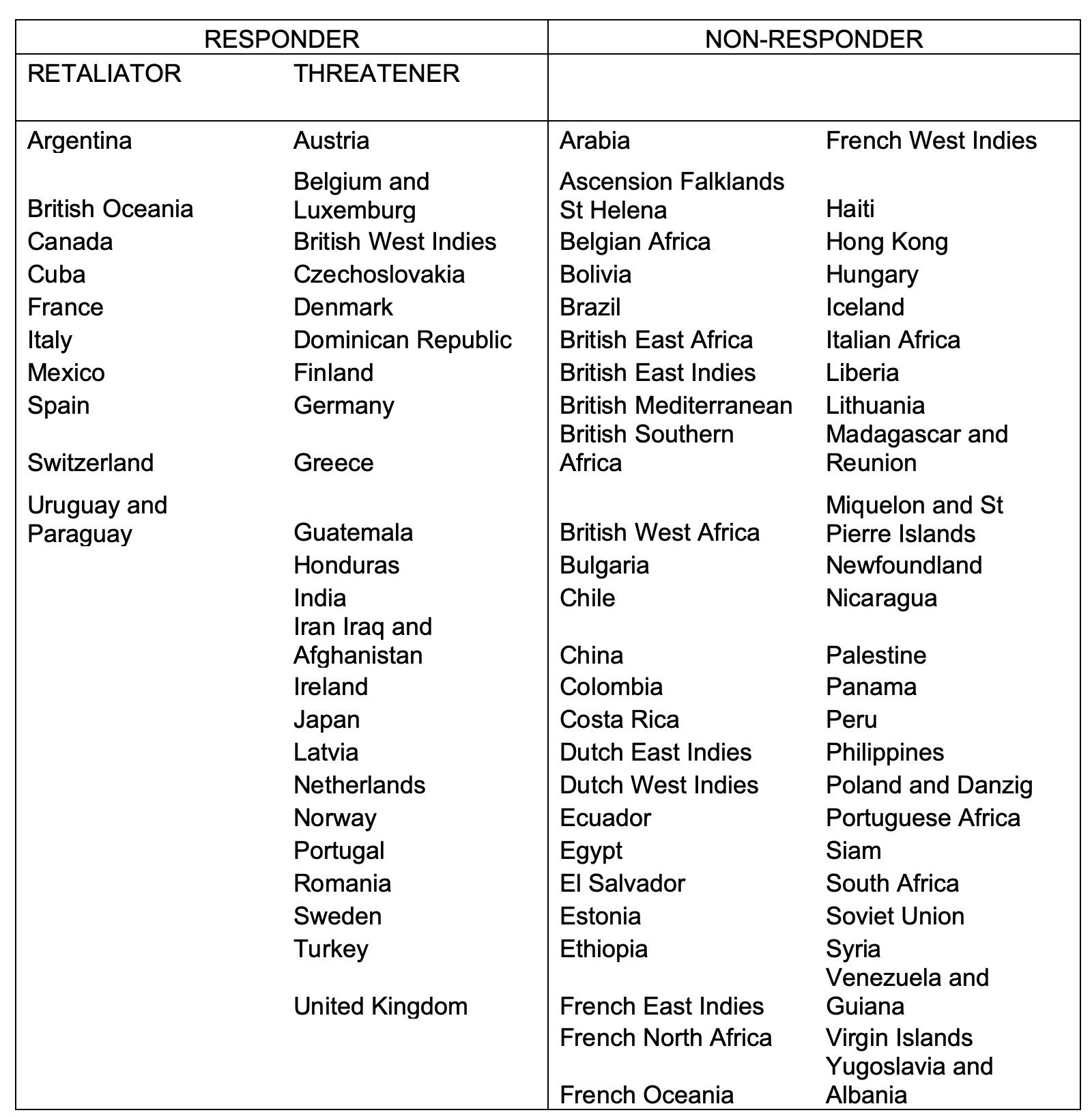In March 2018, as the US was moving towards a more protectionist trade policy, White House National Trade Council Director Peter Navarro predicted that no country would retaliate against America “for the simple reason that we are the most lucrative and biggest market in the world”.1 Meanwhile, opponents of President Trump pointed to the 1930s as a cautionary tale of the unintended consequences of protectionist policy. As Robert J. Samuelson put it, “the ghost of Smoot-Hawley seems to haunt President Trump”.2 The US was an important market in the interwar period also – did that prevent retaliation against US protectionism then? And if retaliation did take place, what were its consequences?3
As it became clear that the Smoot-Hawley legislation was going to be passed, foreign complaints grew louder. By the autumn of 1929, more than 30 countries and colonies had officially protested to the US government. There is no ambiguity about the identity of these protestors, since their complaints were read into the public record while Congress debated the bill.4
On the other hand, the question of who took the next step, and actually retaliated against Smoot-Hawley, has been the subject of academic debate. As Irwin (1998: 337) points out, there were three possible responses to Smoot-Hawley. The first was not to respond at all, but in the context of the Great Depression that might have involved raising tariffs for purely domestic political reasons. The second was to take Smoot-Hawley as a signal that international cooperation had broken down, and erect tariffs as a result. And the third was to take “direct retaliatory measures against the United States”. Only the last of these possibilities constituted retaliation per se. If a country protected its car industry, was that because it wanted to retaliate against the US, or because it wanted to increase domestic car production? Not surprisingly, scholars have disagreed.
At the time, however, there was little doubt in policymakers’ minds that Smoot-Hawley had provoked widespread retaliation – “the Hawley-Smoot tariff in the United States was the signal for an outburst of tariff-making activity in other countries, partly at least by the way of reprisals. Extensive increases in duties were made almost immediately by Canada, Cuba, Mexico, France, Italy, and Spain” (League of Nations 1933:193). Writing in the same year that Smoot-Hawley was passed, Mann (1930) listed 11 countries that were particularly badly affected by the legislation and were either contemplating retaliation or had already retaliated: Argentina, Australia, Canada, Cuba, France, Italy, Mexico, New Zealand, Spain, Switzerland, and Uruguay. The countries concerned raised tariffs on particularly important US exports, while there were calls for boycotts and other measures targeting American goods. Later sources such as Jones (1934) argued that these countries had indeed retaliated, although Eichengreen (1989) doubted whether the protectionism they engaged in always constituted retaliation per se.
Perhaps there is some value in letting the data on bilateral trade flows speak to this issue. In a recent paper (Mitchener et al. 2021), we provide the first systematic quantitative estimates of the impact of retaliation against Smoot-Hawley on US exports. We construct a new, quarterly panel dataset of bilateral trade flows between 1925 and 1938, for 99 countries, colonies, and country groupings. The dataset contains 108,722 raw observations, and accounts for the vast majority of world trade. In 1928, we capture 89% of global imports. The data were collected from national statistical sources, and are to our knowledge the first bilateral trade dataset for the interwar period recorded at a higher than annual frequency. Having high frequency data allows us to exploit the differential timing of retaliatory measures when estimating the impact of retaliation.
We divide our 99 territories into three groups (see the Annex below). First, there are those classified by Mann and Jones as having retaliated, and which we term ‘retaliators’. Second, there are those who officially protested Smoot-Hawley, but were not classified by these authors as retaliators, who we describe as ‘threateners’. Members of these first two groups are collectively referred to as ‘responders’. And third, there are countries that neither retaliated nor protested, which we term ‘non-responders’.
Figure 1 plots US exports to responders and non-responders before and after the passage of Smoot-Hawley. The figure shows that responders accounted for the majority of US exports, so the actions of these countries mattered for aggregate US trade. It also shows that US exports to responders fell more sharply after June 1930 than did exports to non-responders, providing a first hint that retaliation might have been at work.
Figure 1 US exports before and after the passage of Smoot-Hawley
Source: Mitchener et al. (2021)
In order to explore that possibility more rigorously, we estimate a theoretically well-founded gravity model looking at the impact of threatening and retaliating. Threatening and retaliating are captured by dummy variables that are equal to one if the exporter is the US, and the importer falls into either one of these two categories. The dummy variables switch on in the quarter when the country or colony concerned filed a protest or retaliated. As is standard, we include exporter-time, importer-time, and bilateral pair fixed effects, and we control for a variety of potential confounders, including joint membership in various blocs (the sterling bloc, Reichsmark bloc, gold bloc, or British Imperial Preference system; see Jacks and Novy 2019), the Anglo-Irish trade war, trade treaties with the US signed as a result of the 1934 Reciprocal Trade Agreements Act, and simultaneous financial crises. In particular, by including importer-time fixed effects we are controlling for the aggregate decline in the imports of threatening and retaliating countries – any impact of responding that we uncover will capture the differential decline suffered by US exporters to responders.
We estimate our gravity models using both OLS and PPML and find that the impact of retaliating was big. Ceteris paribus, US exports to countries regarded by Mann and Jones as having retaliated fell by between 28% and 33%. More surprisingly, perhaps, US exports to threateners fell by between 15% and 22%, suggesting that de facto retaliation may have extended beyond those countries traditionally regarded as having retaliated.
In order to probe more deeply into the mechanisms involved, we compiled a second panel data set comprising 27,840 quarterly observations of US exports in 104 product categories to 59 trade partners between 1926Q3 and 1932Q2. The dataset captures 35.6% of all US exports in 1928. The use of product-level data allows us to see which products were particularly affected by retaliation overseas. We identified the top 10 US exports in our dataset to each destination, and found that, controlling for aggregate US exports to the economy concerned, exports of these top 10 products to retaliators fell by an additional 33% (exports to threateners fell by an additional 20%). The evidence is consistent with responders targeting particularly important US exports. A final exercise found that exports of cars were especially badly affected, consistent with the historical evidence that automobile exports were in many cases singled out for retaliation.
Peter Navarro was mistaken in 2018, and economic history suggests that this should have come as no surprise. Trade data suggest that the US faced widespread retaliation against Smoot-Hawley, and that the impact was large. While retaliation may indeed have been costly for the countries concerned this did not dissuade them. No matter how lucrative your market, if you behave badly, you risk being punished.
References
Bond, E, M Crucini, T Potter, and J Rodrigue (2018), “Three Lessons from US Interwar History”, VoxEU.org, 27 September.
Eichengreen, B (1989), “The Political Economy of the Smoot-Hawley Tariff”, in R L Ransom and P H Lindert (eds), Research in Economic History.
Irwin, D A (1998), “From Smoot-Hawley to Reciprocal Trade Agreements: Changing the Course of U.S. Trade Policy in the 1930s”, in M D Bordo, C Goldin, and E N White (eds), The Defining Moment: The Great Depression and the American Economy in the Twentieth Century, University of Chicago Press.
Jacks, D, and Novy, D (2019), “Trade Wars may ‘Bloc up’ World Trade”, VoxEU.org, 23 July.
Jones, J M (1934), Tariff Retaliation; Repercussions of the Hawley-Smoot Bill, University of Pennsylvania Press.
Kottman, R N (1975), “Herbert Hoover and the Smoot-Hawley Tariff: Canada, a Case Study”, The Journal of American History 62(3): 609-35.
League of Nations (1933), World Economic Survey 1932-33.
Mann, L B (1930), “Foreign Reactions to the American Tariff Act”, Foreign Policy Association Information Service 6(15): 261-78.
Mitchener, K J, K H O'Rourke, and K Wandschneider (2021), “The Smoot-Hawley Trade War”, CEPR Discussion Paper 15952.
Annex: List of territories used in the analysis
Note: trade flows to or from Uruguay and Paraguay were reported jointly by several countries, so we were obliged to treat these as one entity when constructing our gravity dataset.
Endnotes
1 See @MorningsMaria on Twitter, 2 March 2018.
2 The ghost of Smoot-Hawley seems to haunt Trump”, Robert J. Samuelson, Washington Post, June 27, 2018 (accessed March 11, 2019).
3 See Bond et al. (2018) for a recent study of the macroeconomic impact of tariffs during the 1930s.
4 Canada is an exception, since it appealed directly to President Hoover rather than filing an official complaint with the US State Department (Kottman 1975).








